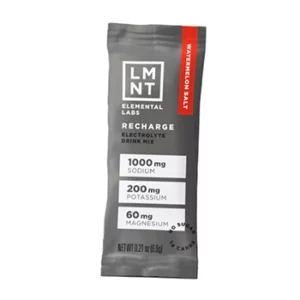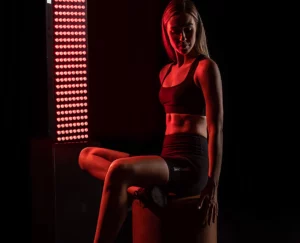If you’ve been following the Olympics, you may have noticed a colorful trend showing up on the bodies of top pros known as taping. Most recently, we’ve noticed the tape on U.S. beach volleyball bosses Kerri Walsh Jennings and April Ross.
Kinesiology taping is a simple, but unusual therapy used to manage pain and prevent injury and you certainly don’t have to be an Olympian to benefit. Kinesiology tape can be used to deal with headaches, back pain, even cramps. When a team member recently used the weird-looking tape to alleviate back pain in a major way, we all took notice and decided to learn more from kinesiologist and yoga pro, Alina Kim. Alina’s new book, Kinesiology Taping for Rehab and Injury Prevention is a 101 guide on the topic that every fit-spired reader should keep on hand…
Kinesiology taping is meant for everyone, but is especially beneficial for those who are going through some sort of rehabilitation due to injury. In my own personal practice, it has been extremely useful, specifically when used post-manual therapy. Having worked with a variety of clients, including gunshot victims, I’ve noticed a drastic difference, especially with lymphatic taping in severely inflamed areas.
Widely used by physical therapists, chiropractors and personal trainers, kinesiology tape provides incredible support while simultaneously stretching so your body can perform its normal range of motion. Here’s what you should know about it, and a few basic taping techniques to get you started…
What You Need To Know
Kinesiology taping is used as temporary treatment for acute and subacute conditions. It can be used to aid those with chronic pain conditions such as arthritis, tennis elbow, ankle sprains, carpal tunnel, inflammation, general pain, and structural misalignment. Kinesiology taping can also be used to prevent injuries and help return the body to homeostasis in cases of lymphatic damage like inflammation.
The usage of kinesiology taping varies. People who’ve had surgeries use it in order to regain some structural function and alignment in the body. Athletes use kinesiology taping in order to keep the body in proper alignment; they also treat it as a preventative measure in regard to injuries. Everyday people use kinesiology taping for maintenance, pain, and proper alignment.
Kinesiology taping strives to prolong the effects of soft tissue work in physical therapy or massage. I highly recommend that all taping techniques follow some sort of manual therapy. In my own experience, I’ve gotten the best results this way.
Why You Should Try It
The purpose of the tape is to prolong any manual therapy that a person has received in that the tape can be worn for up to five days. This has since evolved. Now taping has been used to prevent injury by helping the body stay in a structurally safe position during exercise or competition.
Taping can also alleviate pain if an individual is going through competition slightly injured. With certain issues kinesiology taping can help with inflammation while simultaneously keeping the area stable and controlling some of the pain. It can be beneficial to use taping before a competition as a preventative measure, but it should be combined with manual therapy, otherwise it really only turns into a Band-Aid if serious injury occurs.
How to Get Started
Kinesiology taping was never supposed to be used alone for any condition. It was created to prolong care during chiropractic treatment plans. So it’s safe to say that if you decide to tape yourself (say, for a chronic condition), be sure to work with a professional rehabilitation therapist first.
The Tools: The kinesiological tape method serves many uses, but it’s primarily used in the stabilization of joints and muscles, to increase the longevity of physical therapy or massage therapy after work has been completed, and for alignment issues. There are several brands of tape that can be purchased, but I find that the Kinesio® brand tape works best for my clients.
The Prep: Skin must be free of all oils, hair, and lotions before attempting to tape. The tape will not stick if there’s any of these on the skin. The easiest way to do this is to purchase basic disinfecting wipes that have no aloe or anything on them. You can also make solutions with a little bit of rubbing alcohol and fragrance-free antibacterial soap.
Tension Test: Tape tension can feel a bit complicated at first. I highly recommend cutting a piece of tape and testing out tension. Feel the tape at neutral or zero tension. Then attempt to pull the tape until it’s at 100% maximum tension. Since you’ll be using several techniques, attempt pulling tape while one end is anchored; you’ll use one hand to actually pull the tape from an anchored position. You’ll also attempt to pull the tape with both hands to create “center tension.” You’ll then adhere the tape with tension in the center. Attempt to create 50% tension at the mid-portion of the tape.
Activation: In order to activate the tape, as soon as you complete any taping session, make sure to rub the tape with your hands in order to heat up the tape that you’ve just completed. Rubbing the tape with your hands warms it up, which in turn activates the acrylic adhesive (depending on which tape you use). I highly recommend that you do this with all tape no matter which brand you use. This also helps with the tape adhering to the body.
5 Basic Taping Techniques
I Strip
This technique is very easy. The I strip involves cutting the tape the proper length and rounding off the edges. Rounding the edges creates a clean aesthetic, but the round edges can also prevent the tape from catching to other articles of clothing. When people exercise, their sweat can cause the straight edges to start to fray; rounded edges can prevent this from happening.
Fan Cut
You can use this lymphatic taping technique anytime and anywhere on the body that you find swelling or bruising. Each area of the body has lymphatic duct draining areas. This is where you’d like the anchor portions of the tape to adhere. Anchor the tape at an area that has healthy lymph traffic on the body, normally proximal to the area of swelling. You can also purchase premade fan cuts online or even in stores.
Web Cut
The common mistake with the web cut is cutting through the ends, which is something you don’t want to do here. Web cuts are normally used for space-correction techniques in areas of tight fascial structure, areas of pain, and areas with trigger points/adhesions. Essentially, you’re creating space in the body where there tends to be tightness due to a variety of reasons. The space correction lifts the skin and thus reduces pressure.
Y Strip
The Y strip technique essentially means you split a piece of tape into two pieces without losing the anchor or base, which remains intact. This is a common taping cut you’ll need to master in order to use some of these techniques.
Star Cut
The star technique is another space-correction technique and used anytime you want to create space as previously described with the web cut technique. This technique tends to use more tension and can be applied anywhere on the body that has pain or where the facia is tight. Large or even small sections of the body, like unsightly scars, can benefit from this technique.
Donut Hole
This fairly new technique is used similarly to the lymphatic technique but has the added benefit of alleviating pain. Its main purpose is to alleviate edema and inflammation. It’s important to mention that the actual “hole” in the donut can’t be too large. If the center is too large, there’s no way to decompress the tissues underneath and thus it can’t lift the skin, rendering the technique ineffective.
The Chalkboard Mag and its materials are not intended to treat, diagnose, cure or prevent any disease. All material on The Chalkboard Mag is provided for educational purposes only. Always seek the advice of your physician or another qualified healthcare provider for any questions you have regarding a medical condition, and before undertaking any diet, exercise or other health related program.
















